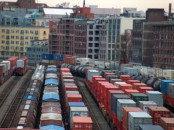World Bank report: Economy resilient, growth to remain steady at 3.5%
Bank says fiscal consolidation may improve investor perception, governance.

The bank’s estimate is one percentage point higher than the projection made by the International Monetary Fund (IMF). CREATIVE COMMONS
The World Bank sounded optimistic on Thursday as it projected that Pakistan’s economic growth would remain steady at 3.5% in the current financial year, underestimating adverse impact of tight monetary and fiscal policies on growth and job creation.
According to the bank’s South Asia Economic Focus report, there will be a marginal decrease of 0.1 percentage point in real gross domestic product (GDP) growth compared with 3.6% the country achieved in the last fiscal year.
The bank’s estimate is one percentage point higher than the projection made by the International Monetary Fund (IMF). The IMF has pressed Pakistan to reverse its easy fiscal and monetary policies and economists believe this change will shave one to two percentage points off growth this year.

However, the World Bank does not agree, arguing that fiscal consolidation may enhance general investor perception of the economy and improve governance performance.
In contrast, the Asian Development Bank (ADB) has forecast that the pace of growth in Pakistan will slow down to 3%. The Asian lender cut its forecast following agreement over an IMF loan programme which requires Pakistan to reduce its budget deficit by 2.2 percentage points this year and tighten monetary policy.
The World Bank noted that fiscal adjustment might lead to contraction of economy as fiscal consolidation might fall disproportionately on public investment. “However, all economic sectors have shown significant resilience in the past year, agriculture and large-scale manufacturing growth remains positive,” it added.
According to a bank spokesperson, Pakistan’s economy has shown resilience and its main sectors contributed positively last year, creating hopes of higher growth.
The spokesperson said constraints like energy shortages have had an impact on Pakistan’s exports, but exporters have found creative ways to overcome them.
Initial steps taken by the new government to reduce load-shedding, keep interest rates low and attract investment have improved expectations of businessmen, particularly exporters, he added. “Expected recovery in Europe and the US should also help to improve prospects for Pakistan’s main exports.”
Despite painting a relatively rosy picture, the World Bank said tepid economic performance has slowed down progress towards poverty reduction and undermined efforts in service delivery.
In its book “Pakistan: The Transformative Path”, the bank has argued that sharp reduction in poverty in the last decade suggests that poverty in Pakistan is highly elastic to growth. Pakistan is good in reducing poverty when the GDP grows but cannot sustain the growth, it said.
The World Bank report noted that Pakistan was facing many crises at the same time. Terrorism, economic problems and energy shortages still remain the main concerns. The country’s weak external position remains the most pressing short-term challenge.
The bank observed that substantial debt repayments have resulted in a marked drawdown on foreign reserves. In terms of import cover, the reserves dropped from about 2.7 months of imports in June 2012 to just 1.2 months of imports in September 2013.
According to the data released by the State Bank of Pakistan (SBP) on Thursday, until October 4 gross reserves held by the central bank slipped below $4 billion. The reserves stood at $3.953 billion, underlining the need to build the coffers.
The reserves held by commercial banks stood at $5.174 billion, according to the SBP.
Commenting on South Asia growth prospects, the World Bank said global capital rebalancing has highlighted structural weakness and vulnerability in South Asia, acting as a wake-up call for policymakers.
It said portfolio capital outflows, triggered by the prospect of tapering quantitative easing in the US, have made current account deficits more difficult to finance across emerging economies.
Published in The Express Tribune, October 11th, 2013.
Like Business on Facebook, follow @TribuneBiz on Twitter to stay informed and join in the conversation.



















COMMENTS
Comments are moderated and generally will be posted if they are on-topic and not abusive.
For more information, please see our Comments FAQ